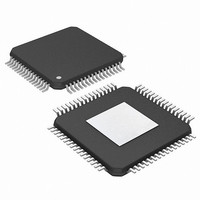PIC24FJ256DA206-I/PT Microchip Technology, PIC24FJ256DA206-I/PT Datasheet - Page 211

PIC24FJ256DA206-I/PT
Manufacturer Part Number
PIC24FJ256DA206-I/PT
Description
MCU PIC 16BIT FLASH 256K 64TQFP
Manufacturer
Microchip Technology
Series
PIC® 24Fr
Specifications of PIC24FJ256DA206-I/PT
Core Size
16-Bit
Program Memory Size
256KB (85.5K x 24)
Core Processor
PIC
Speed
32MHz
Connectivity
I²C, IrDA, SPI, UART/USART, USB OTG
Peripherals
Brown-out Detect/Reset, GFX, LVD, POR, PWM, WDT
Number Of I /o
52
Program Memory Type
FLASH
Ram Size
96K x 8
Voltage - Supply (vcc/vdd)
2.2 V ~ 3.6 V
Data Converters
A/D 16x10b
Oscillator Type
Internal
Operating Temperature
-40°C ~ 85°C
Package / Case
64-TFQFP
Controller Family/series
PIC24
No. Of I/o's
52
Ram Memory Size
96KB
Cpu Speed
32MHz
No. Of Timers
5
Interface
I2C, SPI, UART, USB
Embedded Interface Type
I2C, SPI, UART, USB
Rohs Compliant
Yes
Lead Free Status / RoHS Status
Lead free / RoHS Compliant
Eeprom Size
-
Lead Free Status / RoHS Status
Lead free / RoHS Compliant, Lead free / RoHS Compliant
Available stocks
Company
Part Number
Manufacturer
Quantity
Price
Company:
Part Number:
PIC24FJ256DA206-I/PT
Manufacturer:
AMD
Quantity:
2 100
Company:
Part Number:
PIC24FJ256DA206-I/PT
Manufacturer:
Microchip Technology
Quantity:
10 000
- Current page: 211 of 408
- Download datasheet (4Mb)
15.0
The Serial Peripheral Interface (SPI) module is a
synchronous serial interface useful for communicating
with other peripheral or microcontroller devices. These
peripheral devices may be serial EEPROMs, shift
registers, display drivers, A/D Converters, etc. The SPI
module is compatible with the SPI and SIOP Motorola
interfaces. All devices of the PIC24FJ256DA210 family
include three SPI modules.
The module supports operation in two buffer modes. In
Standard mode, data is shifted through a single serial
buffer. In Enhanced Buffer mode, data is shifted
through an 8-level FIFO buffer.
2010 Microchip Technology Inc.
Note:
Note:
SERIAL PERIPHERAL
INTERFACE (SPI)
This data sheet summarizes the features
of this group of PIC24F devices. It is not
intended to be a comprehensive reference
source. For more information, refer to the
“PIC24F
Section 23. “Serial Peripheral Interface
(SPI)” (DS39699). The information in this
data sheet supersedes the information in
the FRM.
Do not perform read-modify-write opera-
tions (such as bit-oriented instructions) on
the SPIxBUF register in either Standard or
Enhanced Buffer mode.
Family
Reference
Manual”,
PIC24FJ256DA210 FAMILY
®
The module also supports a basic framed SPI protocol
while operating in either Master or Slave mode. A total
of four framed SPI configurations are supported.
The SPI serial interface consists of four pins:
• SDIx: Serial Data Input
• SDOx: Serial Data Output
• SCKx: Shift Clock Input or Output
• SSx: Active-Low Slave Select or Frame
The SPI module can be configured to operate using 2,
3 or 4 pins. In the 3-pin mode, SSx is not used. In the
2-pin mode, both SDOx and SSx are not used.
Block diagrams of the module in Standard and
Enhanced modes are shown in Figure 15-1 and
Figure 15-2.
Synchronization I/O Pulse
Note:
In this section, the SPI modules are
referred to together as SPIx or separately
as SPI1, SPI2 or SPI3. Special Function
Registers will follow a similar notation. For
example, SPIxCON1 and SPIxCON2 refer
to the control registers for any of the 3 SPI
modules.
DS39969B-page 211
Related parts for PIC24FJ256DA206-I/PT
Image
Part Number
Description
Manufacturer
Datasheet
Request
R

Part Number:
Description:
Manufacturer:
Microchip Technology Inc.
Datasheet:

Part Number:
Description:
Manufacturer:
Microchip Technology Inc.
Datasheet:

Part Number:
Description:
Manufacturer:
Microchip Technology Inc.
Datasheet:

Part Number:
Description:
Manufacturer:
Microchip Technology Inc.
Datasheet:

Part Number:
Description:
Manufacturer:
Microchip Technology Inc.
Datasheet:

Part Number:
Description:
Manufacturer:
Microchip Technology Inc.
Datasheet:

Part Number:
Description:
Manufacturer:
Microchip Technology Inc.
Datasheet:

Part Number:
Description:
Manufacturer:
Microchip Technology Inc.
Datasheet:











